Civil Engineering Technology Report: Earthwork and Safety
VerifiedAdded on 2022/08/24
|26
|4123
|49
Report
AI Summary
This civil engineering technology report addresses earthwork activities, including excavation, filling, and compaction techniques. It details methods for measuring volumes and the equipment used, such as bulldozers, excavators, and rollers. The report also examines complex foundation methods like steel grillage and pile foundations, considering geological challenges. Furthermore, it covers drainage establishment, culvert and underpass construction, and basement excavation techniques. The report emphasizes construction site hazards, risk assessments, and safety plans, including health and safety legislation. Finally, it explores geological, quality, and environmental problems, proposing solutions to minimize vibrations, address quality issues, and mitigate noise and air pollution. This comprehensive report offers a detailed analysis of various aspects of civil engineering technology.
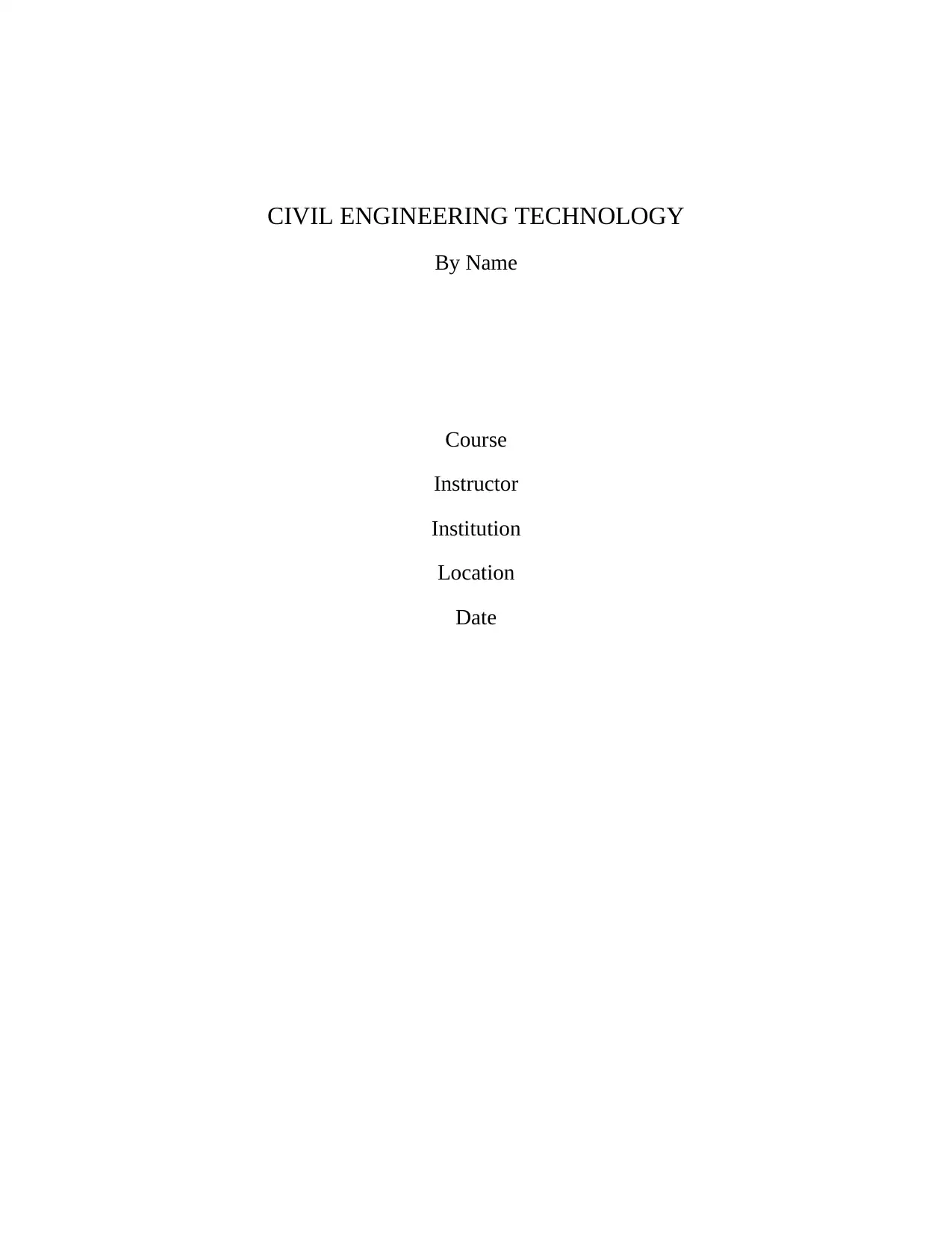
CIVIL ENGINEERING TECHNOLOGY
By Name
Course
Instructor
Institution
Location
Date
By Name
Course
Instructor
Institution
Location
Date
Paraphrase This Document
Need a fresh take? Get an instant paraphrase of this document with our AI Paraphraser

Introduction
Earthwork involves the process of removal after loosening as well as handling of quantities of
the earth during the process of construction. In this particular scenario, the activities or
operations of earthwork will be carried out so that a level terrace can be obtained or established.
The level surface is commonly refered to as the bench.
TASK 1
Section a
Earthwork Activities
In most cases, the operations of the earthwork will be performed so that longitudinal slope is
obtained. Such kind of the surfaces will allow for the establishment or building of camber as well
as drainages. In order to come up with the industrial units as per the demands of the client, the
following primary activities of earthworks will be performed:
Measurement as well as calculations of the excavated volumes
Excavation activities which will include cutting to cross fill, leveling, borrow excavation
and finally U-cut
Hauling, loading and finally unloading
Filling: Majorly includes compaction after spreading
Techniques to be used
In order to effectively measure the volumes excavated accurately, the following techniques are
likely to be employed:
Earthwork involves the process of removal after loosening as well as handling of quantities of
the earth during the process of construction. In this particular scenario, the activities or
operations of earthwork will be carried out so that a level terrace can be obtained or established.
The level surface is commonly refered to as the bench.
TASK 1
Section a
Earthwork Activities
In most cases, the operations of the earthwork will be performed so that longitudinal slope is
obtained. Such kind of the surfaces will allow for the establishment or building of camber as well
as drainages. In order to come up with the industrial units as per the demands of the client, the
following primary activities of earthworks will be performed:
Measurement as well as calculations of the excavated volumes
Excavation activities which will include cutting to cross fill, leveling, borrow excavation
and finally U-cut
Hauling, loading and finally unloading
Filling: Majorly includes compaction after spreading
Techniques to be used
In order to effectively measure the volumes excavated accurately, the following techniques are
likely to be employed:
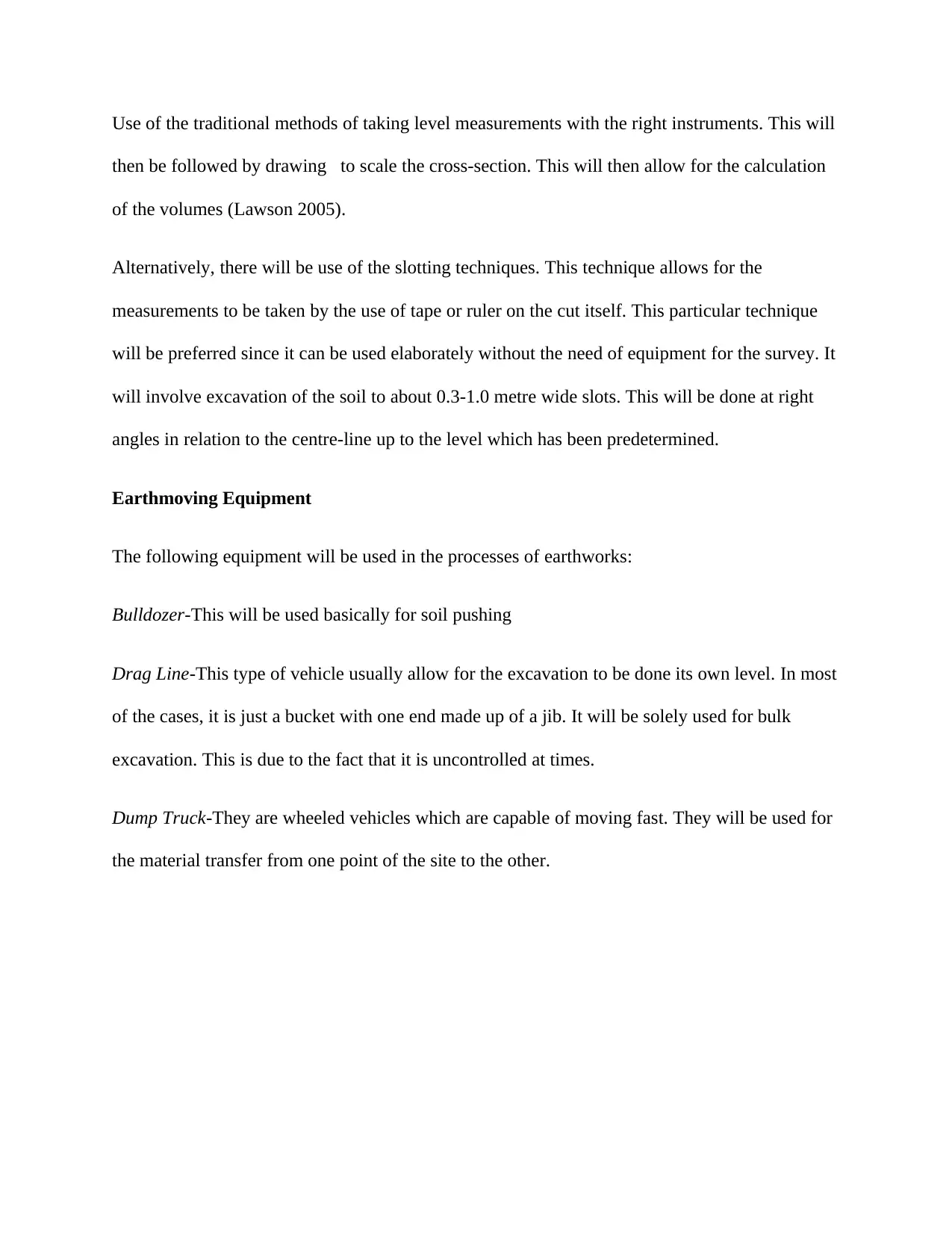
Use of the traditional methods of taking level measurements with the right instruments. This will
then be followed by drawing to scale the cross-section. This will then allow for the calculation
of the volumes (Lawson 2005).
Alternatively, there will be use of the slotting techniques. This technique allows for the
measurements to be taken by the use of tape or ruler on the cut itself. This particular technique
will be preferred since it can be used elaborately without the need of equipment for the survey. It
will involve excavation of the soil to about 0.3-1.0 metre wide slots. This will be done at right
angles in relation to the centre-line up to the level which has been predetermined.
Earthmoving Equipment
The following equipment will be used in the processes of earthworks:
Bulldozer-This will be used basically for soil pushing
Drag Line-This type of vehicle usually allow for the excavation to be done its own level. In most
of the cases, it is just a bucket with one end made up of a jib. It will be solely used for bulk
excavation. This is due to the fact that it is uncontrolled at times.
Dump Truck-They are wheeled vehicles which are capable of moving fast. They will be used for
the material transfer from one point of the site to the other.
then be followed by drawing to scale the cross-section. This will then allow for the calculation
of the volumes (Lawson 2005).
Alternatively, there will be use of the slotting techniques. This technique allows for the
measurements to be taken by the use of tape or ruler on the cut itself. This particular technique
will be preferred since it can be used elaborately without the need of equipment for the survey. It
will involve excavation of the soil to about 0.3-1.0 metre wide slots. This will be done at right
angles in relation to the centre-line up to the level which has been predetermined.
Earthmoving Equipment
The following equipment will be used in the processes of earthworks:
Bulldozer-This will be used basically for soil pushing
Drag Line-This type of vehicle usually allow for the excavation to be done its own level. In most
of the cases, it is just a bucket with one end made up of a jib. It will be solely used for bulk
excavation. This is due to the fact that it is uncontrolled at times.
Dump Truck-They are wheeled vehicles which are capable of moving fast. They will be used for
the material transfer from one point of the site to the other.
⊘ This is a preview!⊘
Do you want full access?
Subscribe today to unlock all pages.

Trusted by 1+ million students worldwide

Figure 1: Dump Truck (Trzeciak and Borrmann 2018)
Shovels-These are also wheeled vehicles that assist in filling up of dump trucks.
Hydraulic Excavators-They are either tracked or wheeled and are capable of excavating below
the level of the truck. They usually have very small capacity although their flexibility is usually
extreme
Grader-It will be used in leveling the fill which has been deposited waiting for the compaction.
Shovels-These are also wheeled vehicles that assist in filling up of dump trucks.
Hydraulic Excavators-They are either tracked or wheeled and are capable of excavating below
the level of the truck. They usually have very small capacity although their flexibility is usually
extreme
Grader-It will be used in leveling the fill which has been deposited waiting for the compaction.
Paraphrase This Document
Need a fresh take? Get an instant paraphrase of this document with our AI Paraphraser
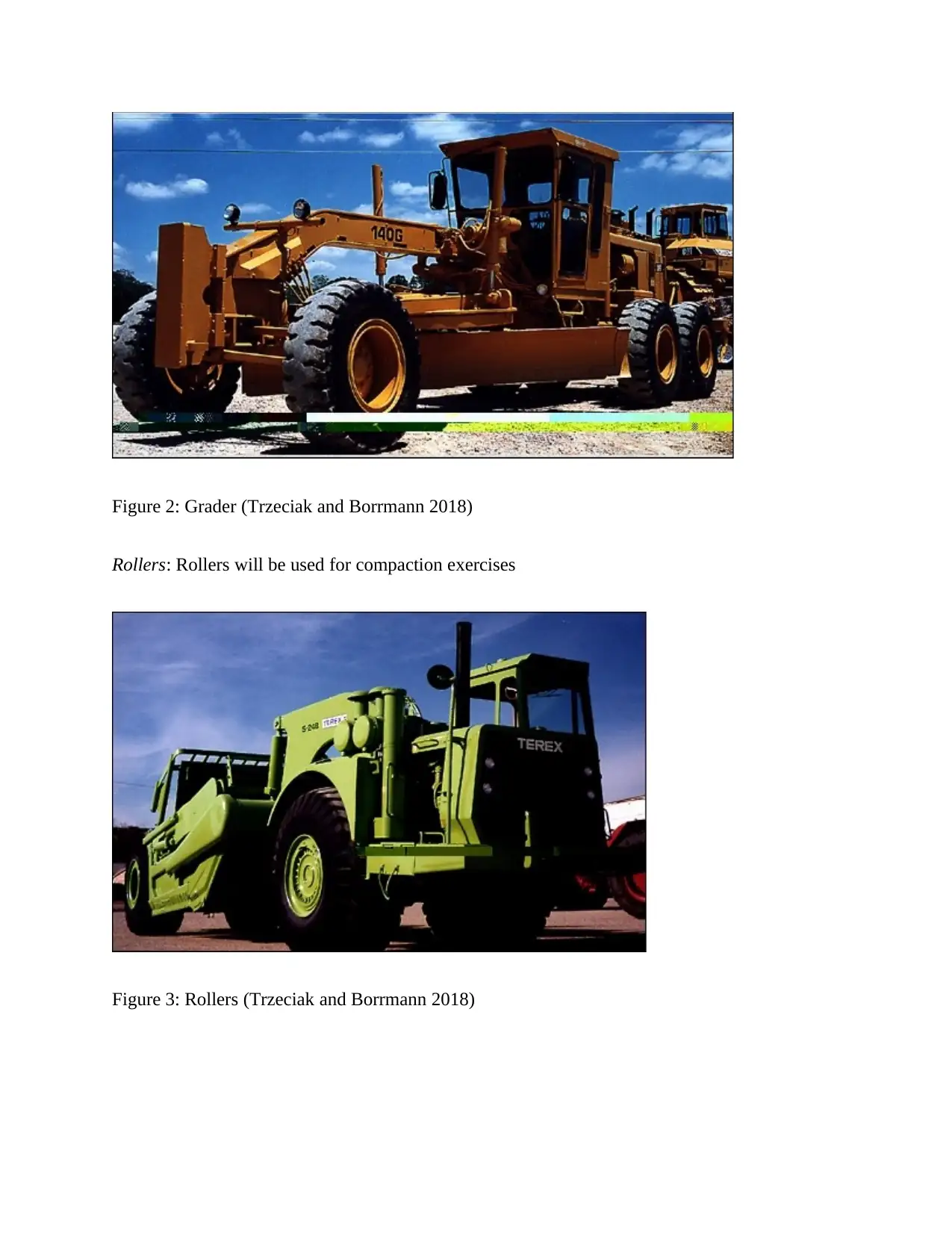
Figure 2: Grader (Trzeciak and Borrmann 2018)
Rollers: Rollers will be used for compaction exercises
Figure 3: Rollers (Trzeciak and Borrmann 2018)
Rollers: Rollers will be used for compaction exercises
Figure 3: Rollers (Trzeciak and Borrmann 2018)
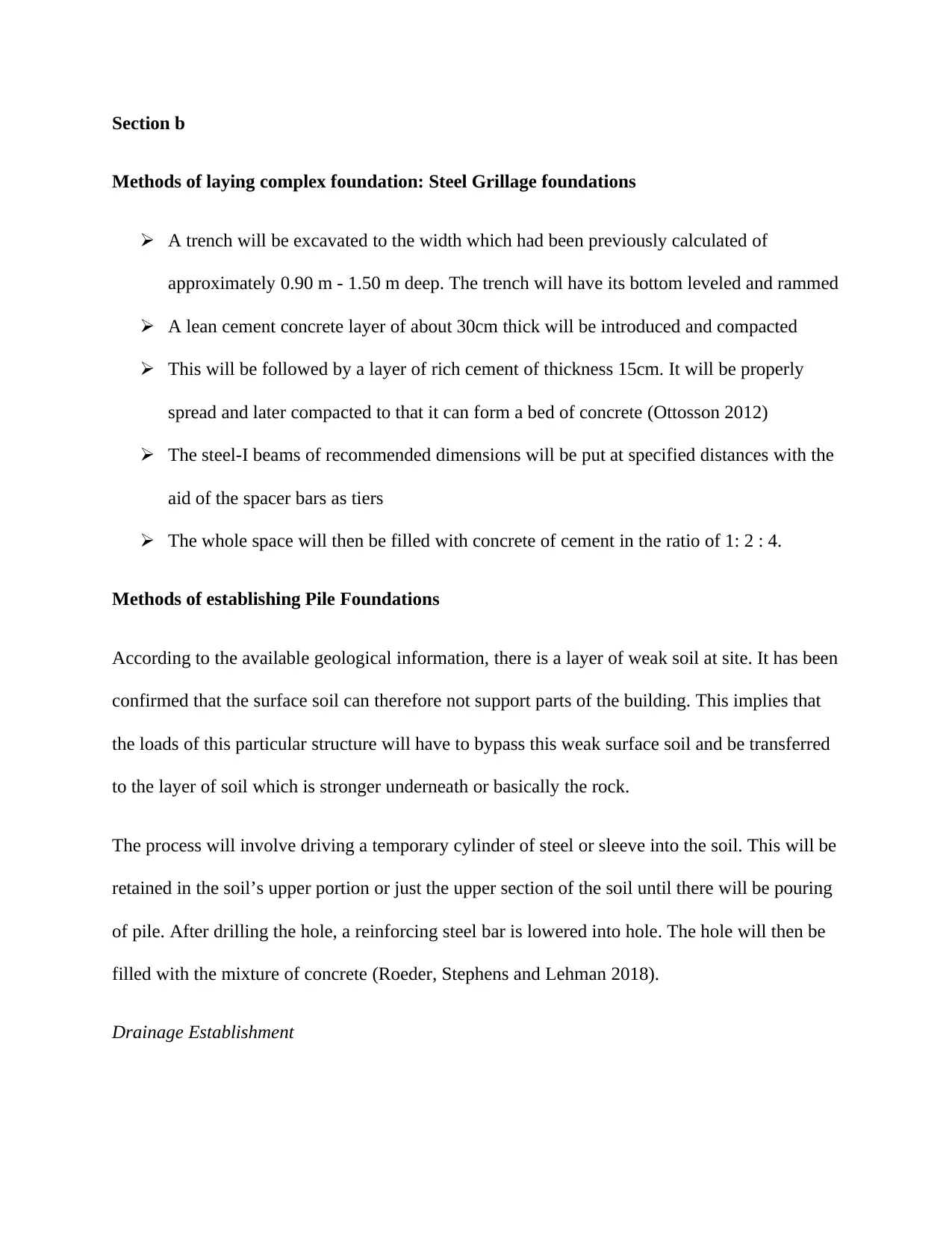
Section b
Methods of laying complex foundation: Steel Grillage foundations
A trench will be excavated to the width which had been previously calculated of
approximately 0.90 m - 1.50 m deep. The trench will have its bottom leveled and rammed
A lean cement concrete layer of about 30cm thick will be introduced and compacted
This will be followed by a layer of rich cement of thickness 15cm. It will be properly
spread and later compacted to that it can form a bed of concrete (Ottosson 2012)
The steel-I beams of recommended dimensions will be put at specified distances with the
aid of the spacer bars as tiers
The whole space will then be filled with concrete of cement in the ratio of 1: 2 : 4.
Methods of establishing Pile Foundations
According to the available geological information, there is a layer of weak soil at site. It has been
confirmed that the surface soil can therefore not support parts of the building. This implies that
the loads of this particular structure will have to bypass this weak surface soil and be transferred
to the layer of soil which is stronger underneath or basically the rock.
The process will involve driving a temporary cylinder of steel or sleeve into the soil. This will be
retained in the soil’s upper portion or just the upper section of the soil until there will be pouring
of pile. After drilling the hole, a reinforcing steel bar is lowered into hole. The hole will then be
filled with the mixture of concrete (Roeder, Stephens and Lehman 2018).
Drainage Establishment
Methods of laying complex foundation: Steel Grillage foundations
A trench will be excavated to the width which had been previously calculated of
approximately 0.90 m - 1.50 m deep. The trench will have its bottom leveled and rammed
A lean cement concrete layer of about 30cm thick will be introduced and compacted
This will be followed by a layer of rich cement of thickness 15cm. It will be properly
spread and later compacted to that it can form a bed of concrete (Ottosson 2012)
The steel-I beams of recommended dimensions will be put at specified distances with the
aid of the spacer bars as tiers
The whole space will then be filled with concrete of cement in the ratio of 1: 2 : 4.
Methods of establishing Pile Foundations
According to the available geological information, there is a layer of weak soil at site. It has been
confirmed that the surface soil can therefore not support parts of the building. This implies that
the loads of this particular structure will have to bypass this weak surface soil and be transferred
to the layer of soil which is stronger underneath or basically the rock.
The process will involve driving a temporary cylinder of steel or sleeve into the soil. This will be
retained in the soil’s upper portion or just the upper section of the soil until there will be pouring
of pile. After drilling the hole, a reinforcing steel bar is lowered into hole. The hole will then be
filled with the mixture of concrete (Roeder, Stephens and Lehman 2018).
Drainage Establishment
⊘ This is a preview!⊘
Do you want full access?
Subscribe today to unlock all pages.

Trusted by 1+ million students worldwide

The process of installing drainage will include the following processes: Installation of silt trench
of the required depth as well as the gradient of the designed. This will be followed by drainage
pipe installation; filter protective layer will then be arranged followed by the connection of
drains which have been fitted with collectors. Finally there will be padding of the pipes of
drainage (Bechtel et al 2017).
Section C
Laying of Culverts and underpasses Procedure
i. The bridge assembly will be excavated with a backhoe
ii. One of the panel assemblies will then be constructed. This will however be decided by
the number of 5-by -5 timbers that will be required for every track (Griffith and Watson
2003)
iii. With the side of the assemblies standing, there will be addition of six top 5-by-5 timber
across members. These are to be cut to at least 3 feet or just 2 inches long.
iv. The top bridge of the assembly will be placed facing up again before addition of top deck
by the use of 9 or 10 2-by-4w. These will be approximately 12 feet in length.
v. The bridge assembly will be hauled to the site before it can be offloaded into the
excavation which had been excavated previously (Peeters and FiberCore 2019)
vi. This will then be followed by backfilling the earth into the voids on each face.
Section D
Complex earth moving operations and deep excavations (Basement Excavation
Techniques)
of the required depth as well as the gradient of the designed. This will be followed by drainage
pipe installation; filter protective layer will then be arranged followed by the connection of
drains which have been fitted with collectors. Finally there will be padding of the pipes of
drainage (Bechtel et al 2017).
Section C
Laying of Culverts and underpasses Procedure
i. The bridge assembly will be excavated with a backhoe
ii. One of the panel assemblies will then be constructed. This will however be decided by
the number of 5-by -5 timbers that will be required for every track (Griffith and Watson
2003)
iii. With the side of the assemblies standing, there will be addition of six top 5-by-5 timber
across members. These are to be cut to at least 3 feet or just 2 inches long.
iv. The top bridge of the assembly will be placed facing up again before addition of top deck
by the use of 9 or 10 2-by-4w. These will be approximately 12 feet in length.
v. The bridge assembly will be hauled to the site before it can be offloaded into the
excavation which had been excavated previously (Peeters and FiberCore 2019)
vi. This will then be followed by backfilling the earth into the voids on each face.
Section D
Complex earth moving operations and deep excavations (Basement Excavation
Techniques)
Paraphrase This Document
Need a fresh take? Get an instant paraphrase of this document with our AI Paraphraser
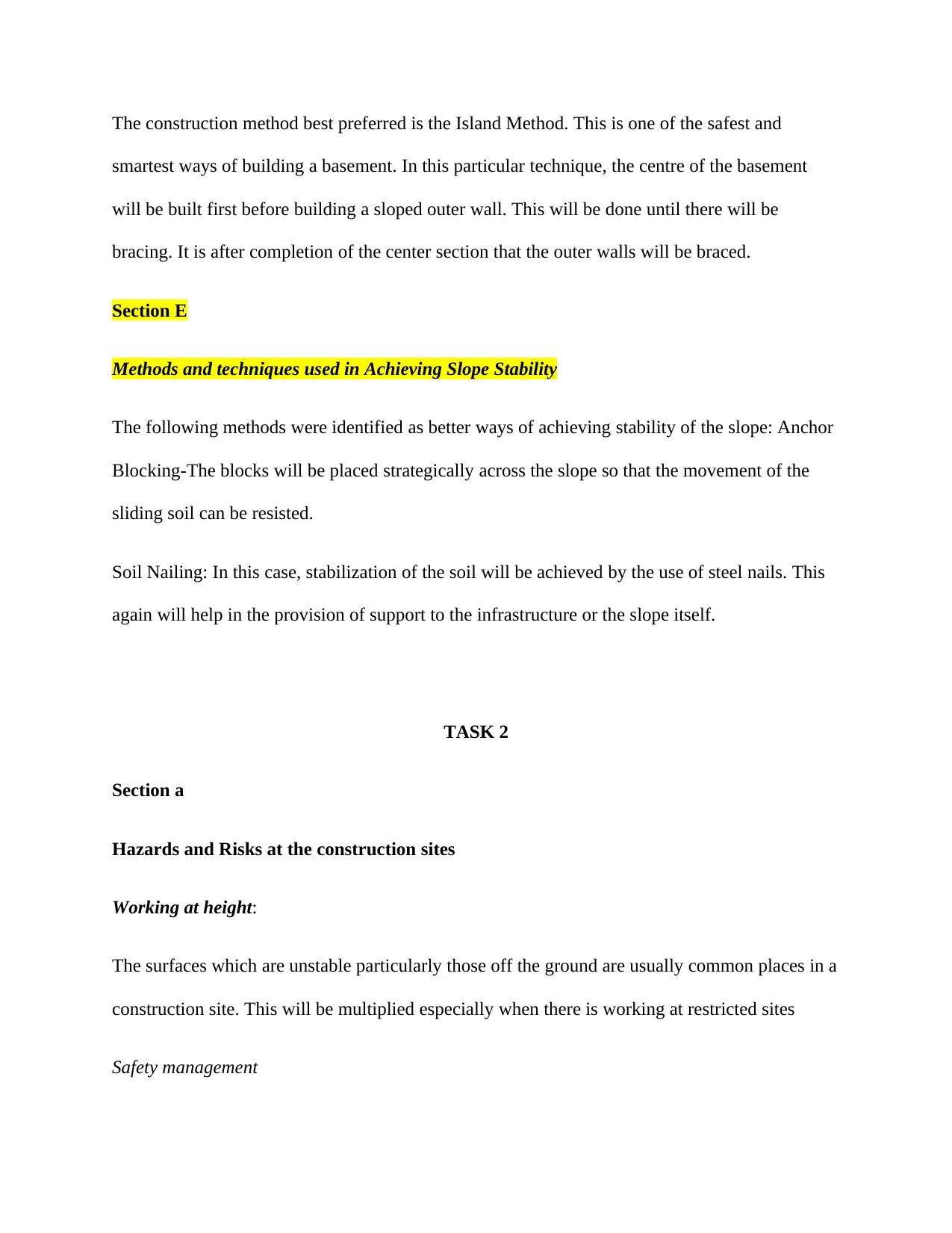
The construction method best preferred is the Island Method. This is one of the safest and
smartest ways of building a basement. In this particular technique, the centre of the basement
will be built first before building a sloped outer wall. This will be done until there will be
bracing. It is after completion of the center section that the outer walls will be braced.
Section E
Methods and techniques used in Achieving Slope Stability
The following methods were identified as better ways of achieving stability of the slope: Anchor
Blocking-The blocks will be placed strategically across the slope so that the movement of the
sliding soil can be resisted.
Soil Nailing: In this case, stabilization of the soil will be achieved by the use of steel nails. This
again will help in the provision of support to the infrastructure or the slope itself.
TASK 2
Section a
Hazards and Risks at the construction sites
Working at height:
The surfaces which are unstable particularly those off the ground are usually common places in a
construction site. This will be multiplied especially when there is working at restricted sites
Safety management
smartest ways of building a basement. In this particular technique, the centre of the basement
will be built first before building a sloped outer wall. This will be done until there will be
bracing. It is after completion of the center section that the outer walls will be braced.
Section E
Methods and techniques used in Achieving Slope Stability
The following methods were identified as better ways of achieving stability of the slope: Anchor
Blocking-The blocks will be placed strategically across the slope so that the movement of the
sliding soil can be resisted.
Soil Nailing: In this case, stabilization of the soil will be achieved by the use of steel nails. This
again will help in the provision of support to the infrastructure or the slope itself.
TASK 2
Section a
Hazards and Risks at the construction sites
Working at height:
The surfaces which are unstable particularly those off the ground are usually common places in a
construction site. This will be multiplied especially when there is working at restricted sites
Safety management
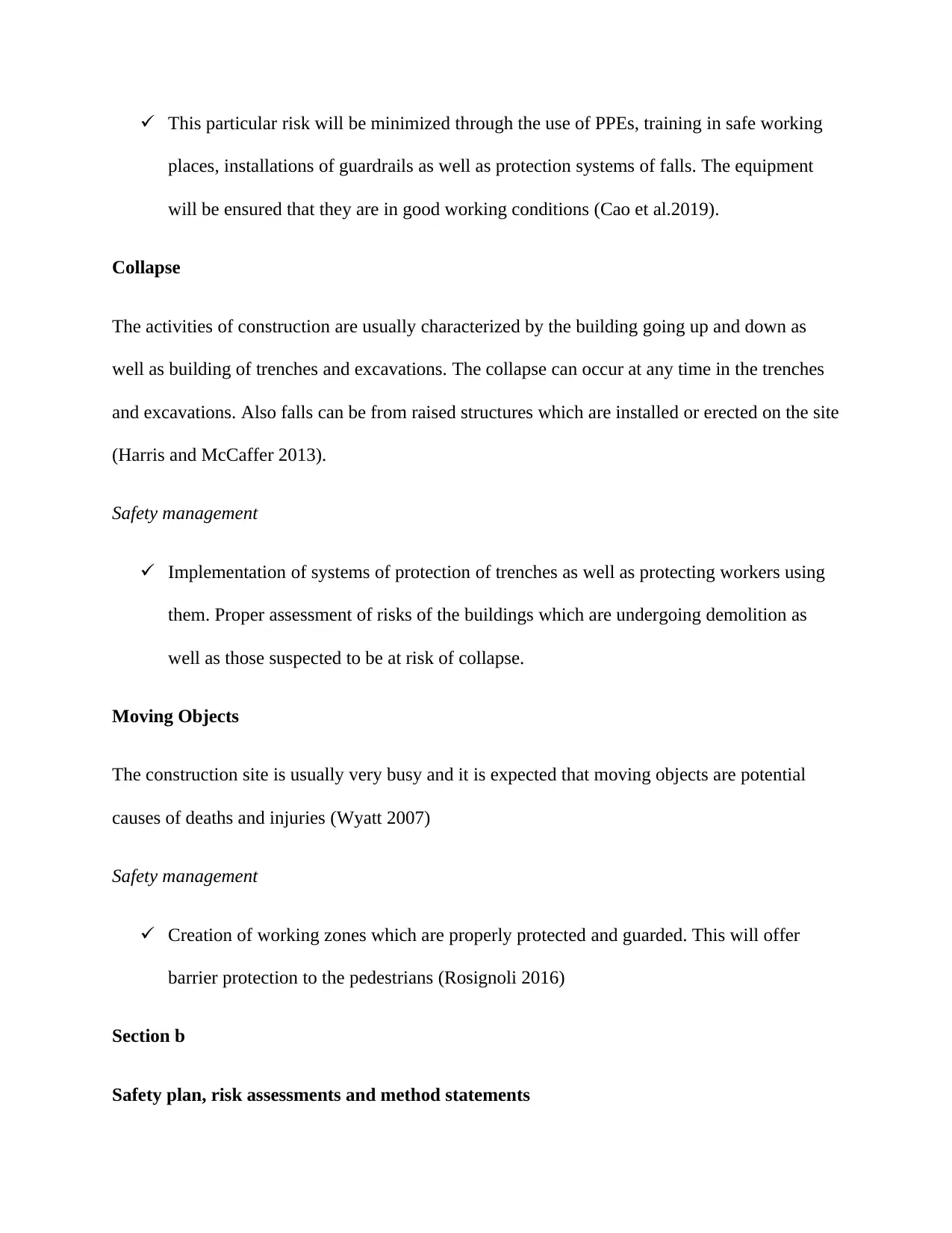
This particular risk will be minimized through the use of PPEs, training in safe working
places, installations of guardrails as well as protection systems of falls. The equipment
will be ensured that they are in good working conditions (Cao et al.2019).
Collapse
The activities of construction are usually characterized by the building going up and down as
well as building of trenches and excavations. The collapse can occur at any time in the trenches
and excavations. Also falls can be from raised structures which are installed or erected on the site
(Harris and McCaffer 2013).
Safety management
Implementation of systems of protection of trenches as well as protecting workers using
them. Proper assessment of risks of the buildings which are undergoing demolition as
well as those suspected to be at risk of collapse.
Moving Objects
The construction site is usually very busy and it is expected that moving objects are potential
causes of deaths and injuries (Wyatt 2007)
Safety management
Creation of working zones which are properly protected and guarded. This will offer
barrier protection to the pedestrians (Rosignoli 2016)
Section b
Safety plan, risk assessments and method statements
places, installations of guardrails as well as protection systems of falls. The equipment
will be ensured that they are in good working conditions (Cao et al.2019).
Collapse
The activities of construction are usually characterized by the building going up and down as
well as building of trenches and excavations. The collapse can occur at any time in the trenches
and excavations. Also falls can be from raised structures which are installed or erected on the site
(Harris and McCaffer 2013).
Safety management
Implementation of systems of protection of trenches as well as protecting workers using
them. Proper assessment of risks of the buildings which are undergoing demolition as
well as those suspected to be at risk of collapse.
Moving Objects
The construction site is usually very busy and it is expected that moving objects are potential
causes of deaths and injuries (Wyatt 2007)
Safety management
Creation of working zones which are properly protected and guarded. This will offer
barrier protection to the pedestrians (Rosignoli 2016)
Section b
Safety plan, risk assessments and method statements
⊘ This is a preview!⊘
Do you want full access?
Subscribe today to unlock all pages.

Trusted by 1+ million students worldwide
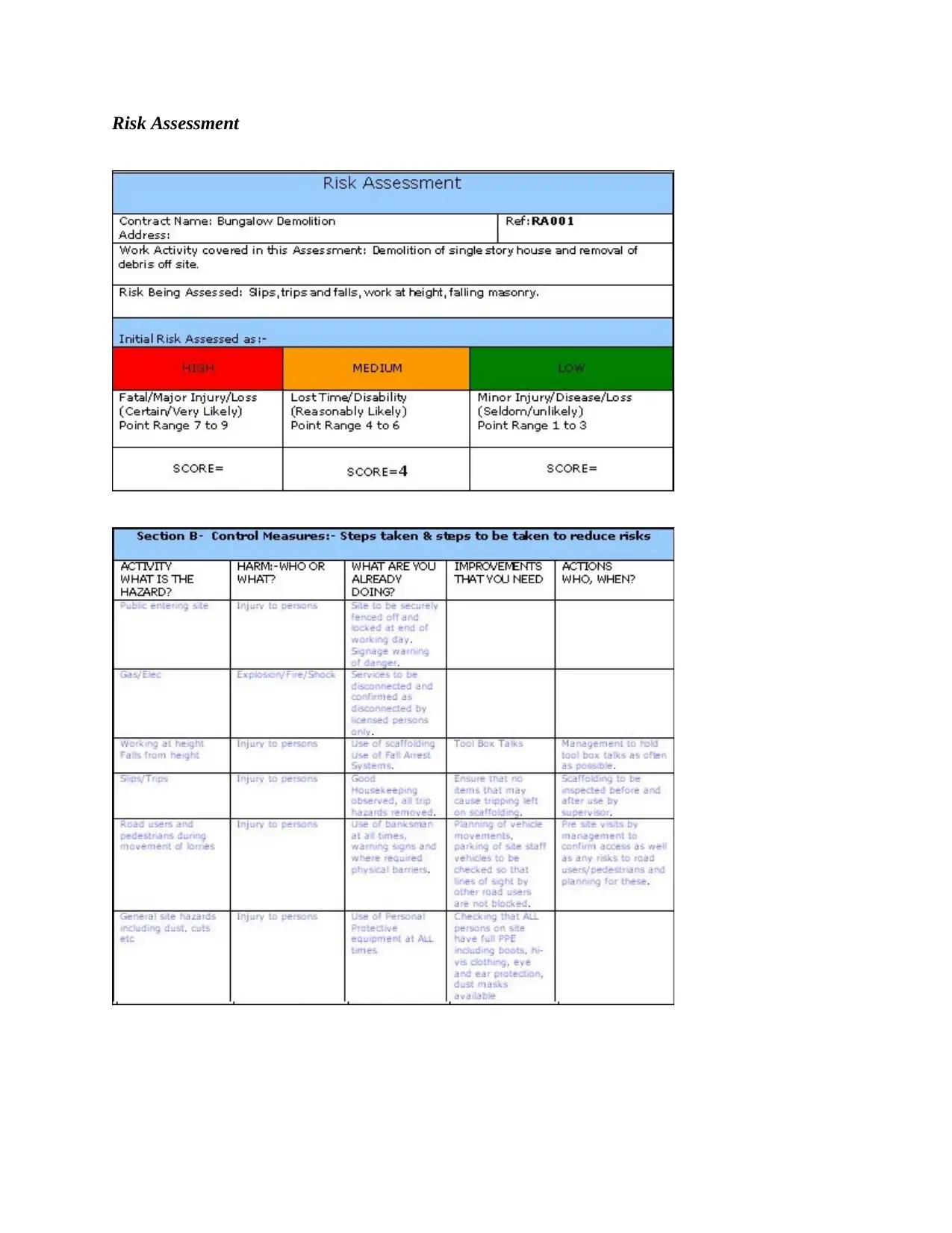
Risk Assessment
Paraphrase This Document
Need a fresh take? Get an instant paraphrase of this document with our AI Paraphraser
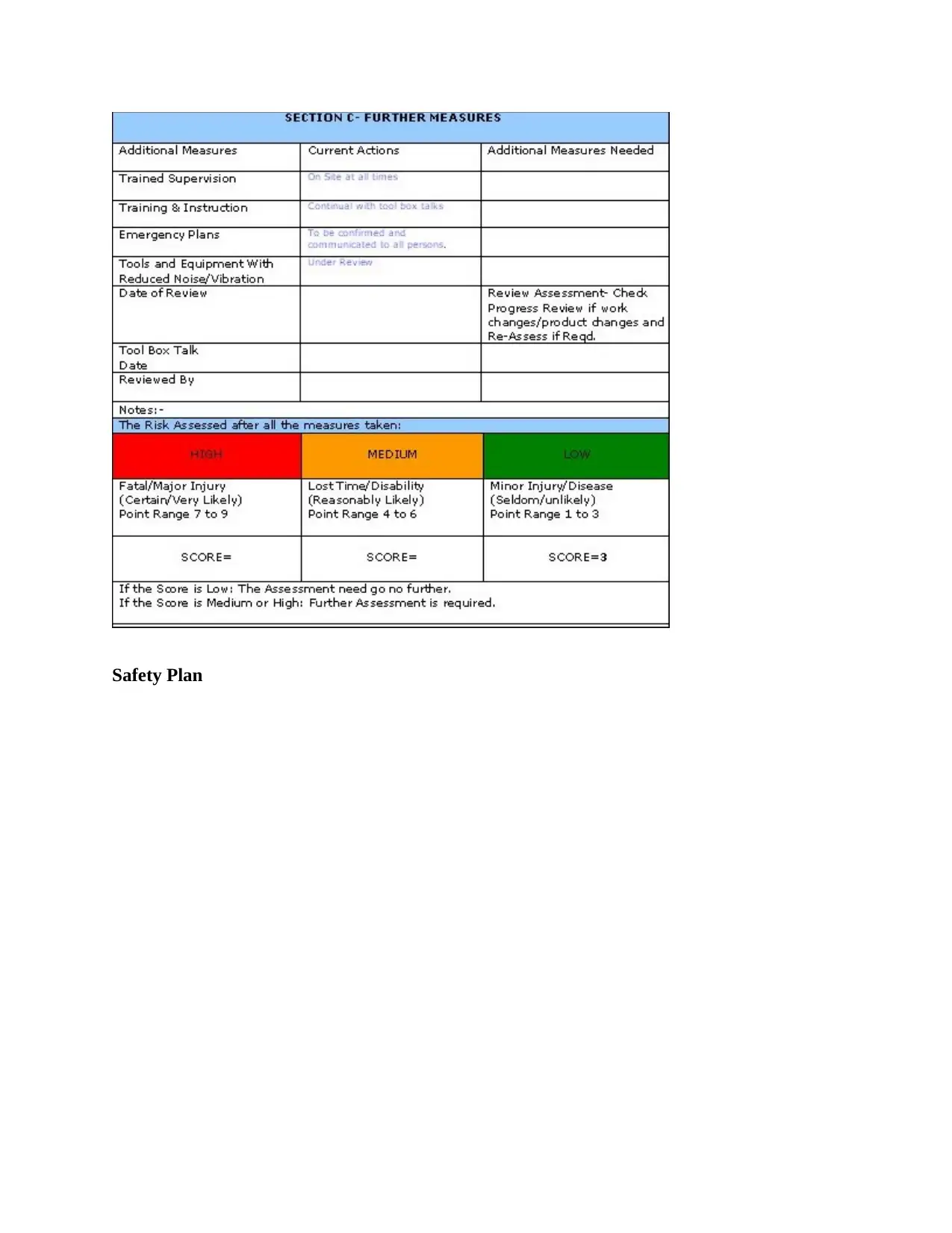
Safety Plan
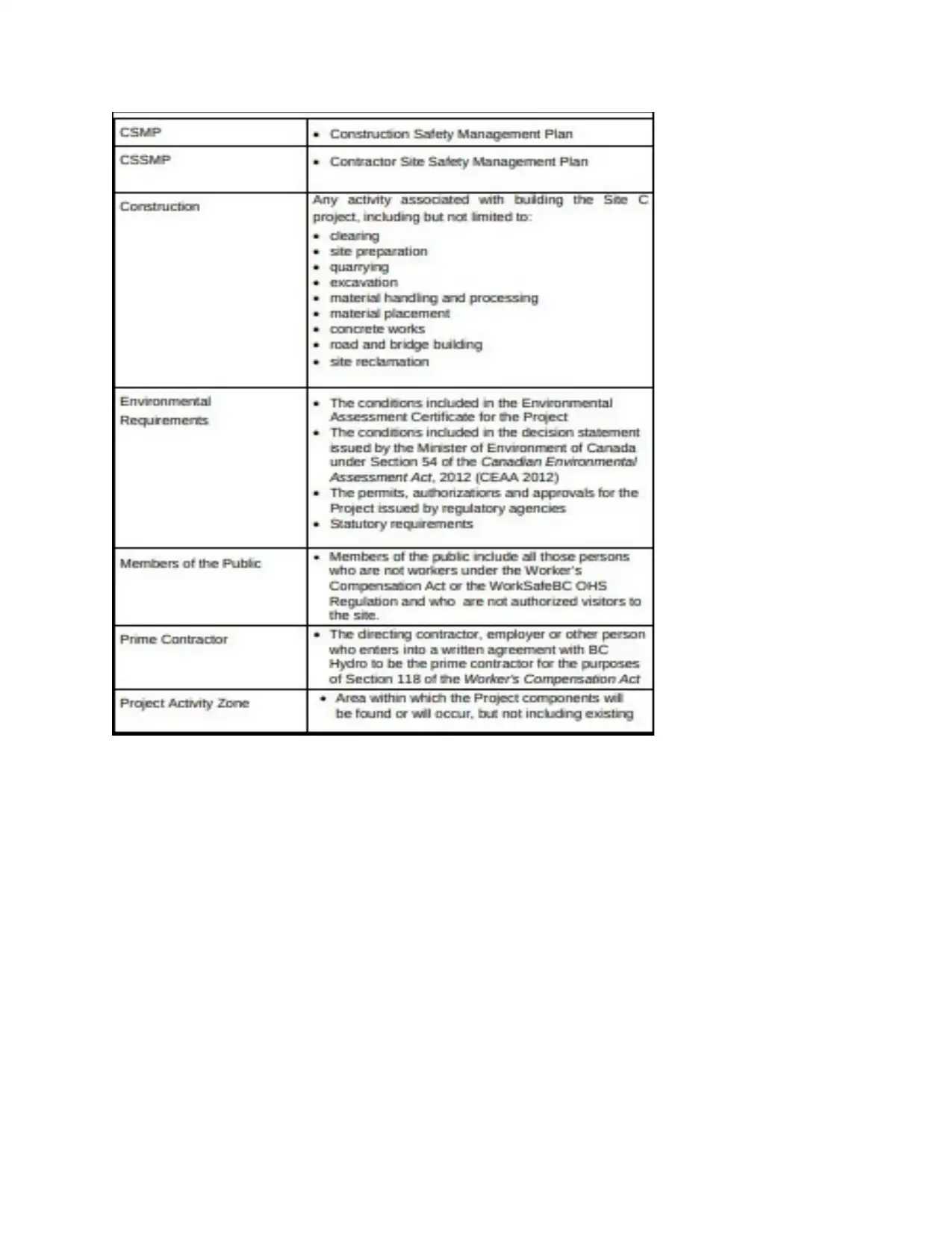
⊘ This is a preview!⊘
Do you want full access?
Subscribe today to unlock all pages.

Trusted by 1+ million students worldwide
1 out of 26
Related Documents
Your All-in-One AI-Powered Toolkit for Academic Success.
+13062052269
info@desklib.com
Available 24*7 on WhatsApp / Email
![[object Object]](/_next/static/media/star-bottom.7253800d.svg)
Unlock your academic potential
Copyright © 2020–2025 A2Z Services. All Rights Reserved. Developed and managed by ZUCOL.




